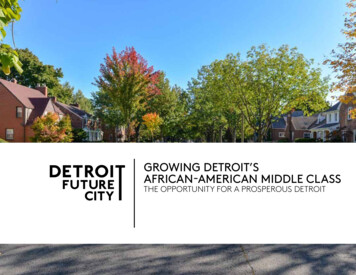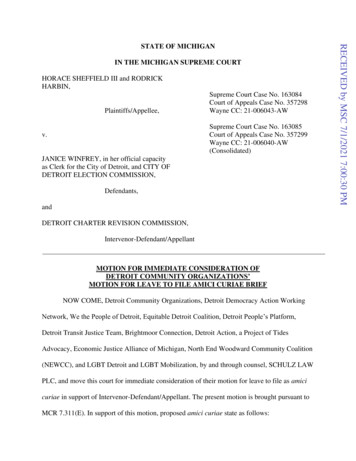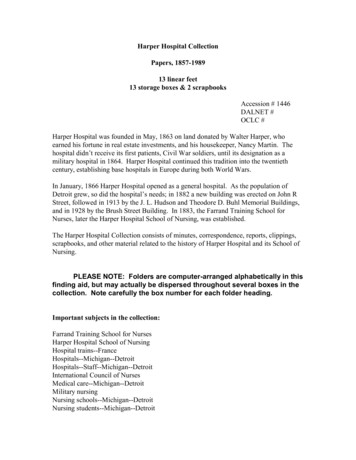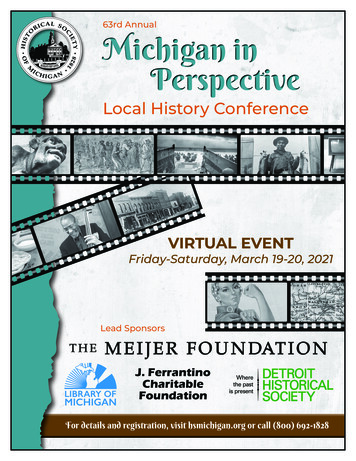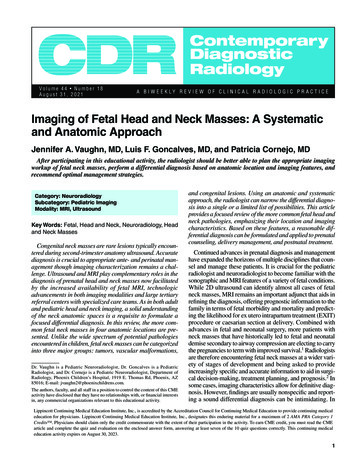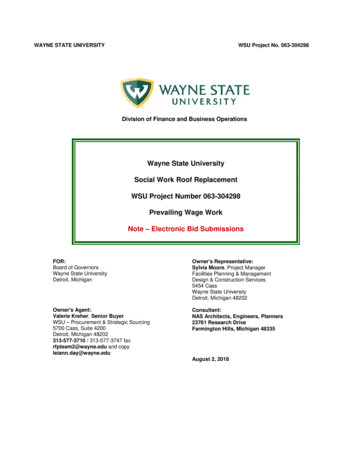
Transcription
For Release and Posting Following theConclusion of the Oral OpinionORAL OPINION ON THE RECORDIn re City of DetroitBankruptcy Judge Steven RhodesNovember 7, 2014
Table of ContentsIntroduction .1The Plan .2The Grand Bargain .3The Pension Settlement.4The Annuity Savings Fund Recoupment Settlement .8The State Contribution Agreement .10The DIA Settlement .12The OPEB Settlement .14The 36th District Court Settlement .15The UTGO Settlement .15The LTGO Settlement.16The COPS Settlement .17The Syncora Settlement .18The FGIC Settlement .19Good Faith .20Best Interests of Creditors .22Fees .25Unfair Discrimination .28Fair and Equitable .33The Constitutional Claims Against the City .35The Exit Financing.37Feasibility.38Conclusion .44
INTRODUCTIONIn chapter 9 of the bankruptcy code, the federal government offers help to the states insolving a problem that, under our constitutional structure, the states cannot solve by themselves.That problem is the adjustment of the debts of an insolvent municipality. Today, this federalbankruptcy court grants that help to the State of Michigan and the City of Detroit.The Court concludes that the City’s eighth amended plan of adjustment meets the legalrequirements for confirmation. Accordingly, the Court confirms that plan.The Court also concludes that the settlements incorporated into the plan of adjustment arereasonable, fair and equitable. Accordingly, the Court approves those settlements.The Court also concludes that the City’s proposed exit-financing meets the requirementsof the bankruptcy code. Therefore, the Court approves the exit financing.This oral opinion will first address the settlements. There are no outstanding objections tothe settlements, except for the ASF recoupment portion of the pension settlement. Nevertheless,the City requested the Court to determine that they are reasonable, fair and equitable.The Court will then review the major issues relating to confirmation. These are good faith,best interests of creditors, professional fees, unfair discrimination, fair and equitable, and thetreatment of the constitutional claims against the City. The Court will then briefly review theCity’s request for approval of the exit financing. The Court will then address feasibility andconclude. The Court will soon issue a supplemental opinion that will more fully address all of theissues.1
THE PLANNearly every creditor group filed litigation against the City seeking the full protection ofits claims, as well as objections to confirmation. The plan is largely comprised of the settlementsof those claims and objections. With only one exception, every group of creditors represented bycounsel has settled with the City. That exception is a small group of creditors with constitutionalclaims against the City.The Court previously approved the settlement with the swap counterparties. Here are thesettlements that Court approves today at the City’s request: The Grand Bargain settlement, which includes the pension settlement, the StateContribution agreement and the DIA settlement. The OPEB settlement. The 36th District Court settlement. The UTGO settlement. The LTGO settlement. The Syncora settlement. The FGIC settlement.Several factors are relevant to the reasonableness of each settlement and are common to allof them. These include the following:All of the creditors in these settlements had filed and vigorously pursued objections to theplan.All of the creditors were highly motivated to pursue those objections and had the resourcesto do so. This would include the appellate process if necessary.2
Many of the objections raised issues that were novel, complex legally and factually, andpotentially significant beyond this case.All of the parties were well represented and well prepared for litigation.For the City, litigating with creditors was incompatible with its goal of a prompt andefficient exit from bankruptcy and start to its revitalization.For the City, the stakes in any of the creditor litigation were high. Even a single loss toany major creditor would seriously compromise its goals in this case.Each settlement was at arms’ length, hard-fought. Each required perseverance, creativityand compromise by all involved.Each of those considerations played a role in each of these settlements.THE GRAND BARGAINThe cornerstone of the plan is the Grand Bargain. It is a collection of settlements among anumber of parties with an interest in the City’s two pension plans and in protecting the City’s art.These parties include: The official committee of retirees. The General Retirement System, GRS. The Police and Fire Retirement System, PFRS. The American Federation of State, County and Municipal Employees, AFSCME. The United Auto Workers Union. The Detroit Retired City Employees Association. The Retired Detroit Police Members Association. The Retired Detroit Police & Fire Fighters Association.3
The Detroit Police Lieutenants and Sergeants Association. The Detroit Police Command Officers Association. The Detroit Police Officers Association. The Detroit Fire Fighters Association. The State of Michigan. A number of charitable foundations. The Detroit Institute of Arts.The settlements represented in the Grand Bargain are the pension settlement, the statecontribution agreement, and the DIA settlement. The plan of adjustment reflects the GrandBargain in its treatment of class 10, which consists of the PFRS claims, and class 11, which consistsof the GRS claims. The State of Michigan, a number of charitable foundations, the Detroit Instituteof Arts and a number of individuals will contribute to the City’s two pension plans a total value of 816 million over 20 years.THE PENSION SETTLEMENTThe key points of the pension settlement are: The allowed claim amount of Unfunded Accrued Actuarial Liability, the UAAL, will be 1.25 billion for PFRS and 1.879 billion for GRS. Through June 30, 2023, the pension plans will use a 6.75% discount rate to value theliabilities and a 6.75% assumed investment return rate to estimate the future growth of their assets. The pension plans will be frozen as of July 1, 2014.4
Active employees continuing to work for the City after July 1, 2014, will have benefitsunder new hybrid pension plans. The pension formulas contained in the new hybrid plans are lessgenerous than those in the present plans. Each pension claimant will receive the Adjusted Pension Amount. For PFRS retirees,this means no reduction in the accrued pension benefit amount but a 45% reduction in the cost ofliving adjustment, COLA. For GRS retirees, the Adjusted Pension Amount is a 4.5% reduction inaccrued pension benefit amount and elimination of COLA. Some GRS retirees will be subject to an annuity savings fund recoupment. Because someparties have objected to this ASF recoupment, the Court will address this separately later. There are provisions for restoration of pension benefit payments in certain circumstances. For 2023, the funding targets are 70% for GRS and 78% for PFRS. For 2053, in 40 years,the targets are 100% for each. PFRS and GRS will each have an investment committee that will make recommendationsto, and in certain situations approve the actions of, their boards of trustees. Until June 30, 2023, the parties may not amend the terms, conditions and rules of theGRS and PFRS relating to the calculation of pension benefits, the investment return assumptions,or the contributions to the pension systems.The pension classes voted to accept the plan by 82% in class 10, PFRS, and 73% in class11, GRS.Despite these strong votes in favor of the plan, the treatment of pension claims in the City’splan of adjustment has been a significant issue in the case. In the Court’s eligibility opinion, itheld that the federal bankruptcy power could impair pension right in a municipal case, even if thestate constitution protects. The Court stands by that decision.5
Now, at the confirmation stage, the Court must determine whether the plan’s treatment ofpension claims meets the legal requirements for plan confirmation and settlement approval. Theplan confirmation issues include good faith, best interests of creditors, feasibility and others. TheCourt will address these questions later. It will now address whether the pension settlement is areasonable settlement.Despite the acceptance of the plan by the pension classes, many pension claimants stillstrongly oppose the impairment of their pension rights in this bankruptcy. They believe that underthe Michigan constitution, their pension rights are not subject to impairment. They credibly statethat they worked hard for the City, that they did nothing wrong, and that these impairments willcause them real hardship. Some also argue that the pension impairments in the plan of adjustmentare unnecessary because the pension plans are in fact fully funded. They further argue that if thepension plans are underfunded, the City should sell the art at the Detroit Institute of Arts or otherCity assets. Many of these objecting parties took the time to come to court to give a strong, sincereand personal voice to their objections.The Court finds that the pension settlement is a reasonable settlement and overrules thoseobjections to confirmation and to the pension settlement.The several representatives of the pension classes appealed this Court’s eligibility decisionto the Court of Appeals. The City of course took the position that the eligibility decision wascorrect and should be affirmed. To determine the reasonableness of the settlement, it is incumbentupon this Court to estimate the parties’ likelihood of the success of the appeal. That is challenginghere. On balance, the Court estimates that the pension creditors’ chances of success on appealwere in the range of 25%.6
The next step would be to determine each side’s best-case scenario. For the City, thatwould plainly be to prevail on appeal and to continue in this chapter 9.For the pension claimants, however, the best-case scenario is much less clear. The Citywould still have no ability to pay the claim even if those claimants were to prevail on appeal.These considerations suggest that it is a vast understatement to say that the pensionsettlement is reasonable. It borders on the miraculous. No one could have foreseen this result forthe pension creditors when the City filed this case. The plan’s proposal is only possible becauseof the pension settlement and the Grand Bargain. The pension reductions in the pension settlementare minor compared to any reasonably foreseeable outcome for these creditors without the pensionsettlement and the Grand Bargain.At the same time, the Court must acknowledge that these pension reductions will causereal hardship. In some cases, it is severe.This bankruptcy, however, like most, is all about the shared sacrifice that is necessarybecause the City is insolvent and desperately needs to fix its future. All of the City’s unsecuredcreditors are making sacrifices. Others sacrifice too, including the City’s residents and visitors,and even the State of Michigan and its residents.Even the City’s professionals are nowcontributing to this process and to the City’s future.As noted, substantial majorities of the two pension classes accepted the necessity of sharedsacrifice for the common good of the City. That collective judgment is entitled to substantialconsideration here.The Court finds that the pension settlement is reasonable and approves it.7
THE ANNUITY SAVINGS FUND RECOUPMENT SETTLEMENTThe Court will now address the Annuity Savings Fund recoupment part of the pensionsettlement. In the City’s long-standing ASF program, GRS employees could voluntarily contributea percentage of their gross pay to a separate pension account. The GRS then invested thesecontributions with the other GRS assets. Each participant’s ASF account increased in value basedon the participant’s contributions and the interest credited to that account.For many years, the GRS credited interest in each participant’s ASF account at the assumedrate of return even when the actual rate of return was less than that. The City claims that thisdiversion of assets increased the GRS unfunded liability. It claims that it is therefore entitled torecoupment of the excess interest credits from the participants to offset that increased unfundedliability. This in turn would reduce the pension cuts to the GRS retirees. The City calculates thatthe total of this claim is approximately 387 million. The GRS and the ASF participants assertthat there is no basis for recoupment.The parties have settled this dispute. The key points are: The ASF Recoupment amount for each ASF participant will be the amount of excessinterest that GRS credited to the participant between July 1, 2003 and June 30, 2013. The GRS will amortize each ASF participant’s recoupment amount over the particpant’slife expectancy with interest at 6.75%, to be deducted from the participant’s monthly pensioncheck or ASF account. The plan of adjustment caps the ASF recoupment at 20% of the highest value of eachparticipant’s ASF account between July 1, 2003 and June 30, 2013. An additional cap limits thecombined pension reduction and ASF recoupment to 20% of such participant’s annual pension.8
Each participant that is subject to the ASF Recoupment will have the option to pay theASF Recoupment amount in a single lump sum cash payment. The settlement will net approximately 190 million for the GRS, which is about 49% ofthe City’s calculation of its claim here.Several participants object to the ASF recoupment in the plan of adjustment. They argue:1. The ASF recoupment violates the applicable statute of limitations.2. Under state law, the City’s recoupment claim has no merit.3. They did nothing that justifies imposing this liability on them.4. The GRS board did nothing wrong.5. The City has no standing to assert the claim.6. They do not consent to the lesser treatment of their pension claim in class 11that results from the recoupment.7. The treatment of the City’s recoupment claim in the plan violates their right tobe heard on the merits.8. The City did not properly disclose the6.75% interest rate.9. The interest rate is illegal, usurious and unfair.10. The Court should carve the ASF settlement out of the plan and then approve theplan.The Court overrules those objections.The ASF recoupment settlement is a part of the pension settlement and therefore a part ofthe Grand Bargain. It is also a part of the City’s plan of adjustment. The Court, therefore, hasonly two issues to consider. The first is whether the settlement is reasonable. The second iswhether the plan provisions that incorporate the ASF settlement violate the bankruptcy code.9
It is not for the Court to rule on the merits of the City’s ASF recoupment claim or the meritsof the participants’ defenses. The Court only to reviews the parties’ positions to determine whetherthe settlement is reasonable.The Court finds substantial merit in the City’s recoupment claim. The legal authority ofthe GRS board to credit interest in excess of the actual rate of return was doubtful. The prudenceof the practice was even more doubtful. The Court also considers that the asserted defenses haveless merit.On balance, it appears that the City’s recoupment claim would have a reasonable likelihoodof success, 60-70%. However, the length, complexity and expense of litigation on the claim wouldbe substantial. Should the City prevail, issues of collectability against ASF participants could alsobe substantial, depending upon the structure of the final judgment.The Court also considers that this settlement is a part of the much larger settlement of allpension-related issues. The class of claims affected by the settlement, class 11, accepted thesettlement by a vote of 73%. Finally, the Court notes that the caps and other limitations on therecoupment amount that the parties negotiated should reduce the hardship of it.Fairly weighing these factors suggests that the ASF recoupment settlement is well withinthe range of possible reasonable settlements. The Court approves it.THE STATE CONTRIBUTION AGREEMENTThe Court will now address the state contribution agreement.This agreement settles the state’s potential liability for the underfunding of the GRS andthe PFRS under the pension non-impairment provision of the Michigan constitution, Article IX,section 24. It also supports the City’s plan of adjustment. The key points of this agreement are:10
The state of Michigan will immediately contribute 194.8 million. The City, GRS and PFRS will establish an income stabilization program established toensure that pension reductions do not cause any retirees to fall into poverty. This incomestabilization program will receive a portion of the payments on the Stub UTGO Bonds, which theCourt will describe later. The pension claimants will release the state and its related entities from liability and ceaselitigation related the chapter 9 case, PA 436, or the pension provisions of the Michigan constitution.The claim settled here would not be a frivolous claim. The language of article IX,section 24, of the Michigan constitution can be read to support the claim. The non-impairmentlanguage is absolute and the state is in a much better position than retirees to monitor and enforcethe non-impairment of municipal pensions.There is nonetheless no precedent for such a claim. Any litigation of it would be long,complex and expensive. If the state loses, it would be responsible for the Detroit pensionunderfunding of 3 billion. It might also then be responsible for the entire unfunded liability ofevery municipality in the state. That would be disastrous for the state.The question then is whether the state’s contribution is a fair settlement to obtain a releaseof any liability that it might have on this claim. As noted, the contribution is 195 million.The novelty and the lack of precedent make judging its likelihood of success challenging.The litigation would, however, be high-risk for all concerned.The parties have settled, with the help of the DIA and the charitable foundations. Themany skilled and capable representatives of the pension claimants have concluded that the statecontribution agreement is fair. They recommended it to their pension claimants, who, in turn,voted strongly to support it and to release their potential litigation claims.11
In the circumstances, the Court finds that it is reasonable, although perhaps at the lowestend of the range of reasonable settlements. The Court approves it. For reasons that the Court willexplain in its written opinion, the Court also approves the release of the state and the state relatedentities.THE DIA SETTLEMENTThe Court will now address the DIA settlement.This settlement resolves all of the disputes relating to the rights of all parties with respectto the DIA and the art. The key points of this settlement are: The DIA will secure and guaranty commitments for contributions to the GRS and thePFS of 100 million over twenty years. Various local and national charitable foundations will contribute 366 million to the GRSand PFRS over 20 years. The City will transfer the art to the DIA Corp., which will hold the art in a perpetualcharitable trust for the benefit of the people of the City and the State.Two issues arise here. The first is whether the DIA settlement is a fair settlement. TheCourt will address this issue now. The second is whether the settlement is consistent with the bestinterests of creditors test. The Court will address that issue later.Addressing the fairness of the settlement, the Court will first examine the relative strengthsof the parties’ positions. Both the Michigan Attorney General and the DIA itself take the positionthat the DIA art is subject to a trust that prohibits the City from selling it to pay debts and placesit beyond the creditors’ reach. The DIA also asserts that the donors of many of the pieces of arthad imposed specific transfer restrictions on them.12
The evidence supports these assertions. The Court was especially impressed with thetestimony of Ms. Erickson on these points, and with the historical documentary evidence that theDIA cited in its brief and that was admitted in evidence.The evidence further establishes that nationally accepted standards for museums prohibitthe de-acquisition of art to pay debt. The creditors also admitted, perhaps grudgingly, that nocreditor had ever considered the value of the art as a possible source of repayment when it decidedto lend money to the City or to acquire City debt.On the other hand, the creditors did submit substantial evidence and legal groundssupporting the contrary view that the City can legally sell or monetize the DIA art.On balance, the Court concludes that in any potential litigation concerning the City’s rightto sell the DIA art, or concerning the creditors’ right to access the art to satisfy its claims, theposition of the Attorney General and the DIA almost certainly would prevail.However, evidence also established that any such result in litigation might well have takenyears to achieve and would have been costly to pursue. It also would have been difficult for theCity to endure the delay and expense while at the same time attempting to revitalize itself. TheDIA and the attorney general state with credibility that they would vigorous contest any attemptto sell any art. Credible evidence also establishes that an attempt by the City to sell its art mightresult in a cancellation of the county millage taxes that support the DIA’s operations and constitutealmost 70% of the DIA’s budget.The Court concludes that the DIA settlement was a most reasonable and favorablesettlement for the City and its pension creditors. The Court readily approves it. Accordingly, theCourt approves all aspects of the grand bargain.13
THE OPEB SETTLEMENTThe Court will now review the OPEB settlement.The City is currently obligated to its retirees for other post-employment benefits, OPEB.This includes health care and life insurance benefits. The City claimed the OPEB liability is 3.8billion. The retiree committee asserts that it is 5 billion. The difference largely results fromdifferences in certain actuarial assumptions and discount rates. They also disagreed about how toaccount for postpetition OPEB payments. Either value would make the OPEB liability the City’slargest single liability.The parties settled. The key points of this settlement are: The allowed amount of OPEB Claims is 4.3 billion. Of that, 2.2 billion is for PFRSretirees and 2.1 billion is for GRS retirees. The City will establish two voluntary employees’ beneficiary associations, known asVEBAs, to provide post-employment benefits to retirees and certain of their beneficiaries anddependents. The City will distribute New B Notes and other assets to fund the VEBAs. Various sources will fund the start-up costs for the VEBAs. The City will have no further responsibility to provide other post-employment benefits.The plan treats the OPEB claim in class 12. The estimated recovery for Class 12 OPEBclaims is 10%. Class 12 accepted the plan.The retiree committee’s OPEB litigation sought to prohibit the City from terminatingOBEP benefits. It asserted largely equitable grounds relating to the hardship that terminating thesebenefits would naturally cause to retirees. There did not appear to be any substantial legal groundsfor the requested relief. The City’s likelihood of success was very high. The OPEB claim is an14
unsecured claim. Unlike the retirees’ pension claims, their OPEB claims had no arguableconstitutional protection.The 10% recovery for class 12, the OPEB class, is approximately the recovery of otherunsecured creditors. The class voted to accept it by over 88%. The Court finds that the OPEBsettlement is reasonable. The Court approves it.THE 36TH DISTRICT COURT SETTLEMENTThe Court will now discuss the 36th District Court settlement.When the City filed bankruptcy, the 36th District Court was defending severalemployment-related claims. Because the City is legally required to fund the 36th District Court,it would ultimately be responsible for any judgments against the 36th District Court in thoseproceedings. The parties in the litigation settled with the City. The aggregate liquidated allowedamount of the claims is 6 million.These claims are in class 17. Their recovery is 33%. They accepted the plan by a vote of100%. The Court finds that this settlement is reasonable. The Court approves it.THE UTGO SETTLEMENTThe Court will now address the UTGO bond settlement.Postpetition, the City defaulted on its obligation to make payments on these Unlimited TaxGeneral Obligation bonds. The bond insurers paid claims on the defaulted payments.In the resulting litigation, the UTGO bond creditors claimed that portions of the City’sproperty taxes could only be used to pay their claims and that they had a lien on that stream ofrevenues. They also asserted that this revenue was “special revenue” in chapter 9, entitled tospecial protections.15
The City opposed the litigation, contending that the UTGO claims were unsecured claims.The City and the bond insurers settled. The key points of this settlement are: The allowed claim on the UTGO Bonds will be 388 million. Just under 288 million of the UTGO Bonds will be restructured and reallocated amongthe holders of the bonds. Approximately 43 million the UTGO bonds, which parties have called the Stub UTGObonds, will be reinstated to existing holders. However, those holders’ rights to payment on thoseStub UTGO bonds will be dedicated to the income stabilization program that is part of the StateContribution Agreement, which the Court mentioned earlier.The plan classifies the UTGO Bond Claims in Class 8. The recovery is 74%. The classaccepted the plan by a vote of 87%.The UTGO settlement, 74%, is the highest settlement percentage that the City agreed tofor unsecured creditors. The City’s chance of success on the merits of the litigation was a cointoss. On the other hand, the consequence to the City of losing on this issue could have been dire.It would have lost access to the portion of its property tax revenue that the UTGO bondholdersclaimed.The Court concludes, therefore, that the UTGO settlement is within the range of possiblereasonable settlements, although perhaps at the upper end of that range. The Court concludes thatthese circumstances do warrant the premium that the settlement reflects. The Court thereforeapproves it.THE LTGO SETTLEMENTThe Court will now discuss the LTGO settlement.16
The City has almost 164 million in outstanding limited tax general obligation bonds,called LTGO bonds. Postpetition, the City defaulted on its obligation to make interest paymentson the LTGO Bonds. On both occasions, Ambac Assurance Corporation, insurer of two-thirds ofthe LTGO bonds, paid claims on the defaulted payments. In the resulting litigation, the LTGOclaimants argues that their claims were entitled to secured treatment and that state law requires theCity to pay the LTGO bonds as a first budget obligation. The City asserted that the LTGO claimswere unsecured claims.The parties settled their disputes. The key points of this settlement are: The City may either issue new LTGO Bonds in the amount of 55 million or pay 55million in cash using exit financing. The City has elected to make the 55 million cash paymentfrom the exit financing. The City will also distribute 17.3 million in Excess New B Notes to the holders of LTGObond claims.The plan classifies the LTGO bonds claims in Class 7. The recovery for class 7 is 41%.The class accepted the plan.The Court’s judgment is that the City had a substantial likelihood of prevailing in theLTGO litigation, perhaps a 75% chance. The 41% LTGO settlement is within the range ofreasonable settlements. The Court approves it.THE COPS SETTLEMENTThe Court will now address the Syncora settlement and the FGIC and COPs settlement.Both of these are, in part, addressed in class 9 of the plan. Each Class 9 Claim holder will receiveits pro rata share of almost 98 million in New B Notes, 88 million in New C Notes and 2517
million in Settlement Credits. The settlement credits may be used to offset up to 50% of thepurchase price of certain eligible City assets.THE SYNCORA SETTLEMENTSyncora an
The next step would be to determine each side's best-case scenario. For the City, that would plainly be to prevail on appeal and to continue in this chapter 9. For the pension claimants, however, the best-case scenario is much less clear. The City would still have no ability to pay the claim even if those claimants were to prevail on appeal.
